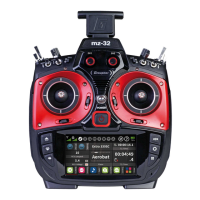Page 26 of 49 S1024.mz-32-V2.1-EN
Receiver Binding
Bind Group
To establish a connection with the transmitter, a Graupner HoTT receiver
must first be "bound" to at least one model memory. This process is
generally called "binding" and it needs to be repeated each time a new
receiver is installed in a model.
By default, the "binding" of a receiver is always carried out as part of a so-
called bind group. When binding an unbound model memory, the next free
bind group is automatically suggested. Each time the suggested bind group
is accepted the model will have an exclusive bind with that group therefore,
a model-specific binding takes place.
The corresponding bind ID is shown in the "Bind" column at the right edge
of the model list. Alternatively, a model memory may also be bound
"globally" or within a bind group.
For an unbound model memory, the default is the next free binding group.
However, if the model memory is unbound the suggested bind group can be
changed by tapping the icon on the “Bind Group” field.
You can select from the following options:
• "Global" enables the receiver to respond to the transmitter signal on
a non-exclusive basis. What this means is that any other receiver that
is bound as global will respond to the transmitter signal of another
model memory that was also bound as global. This can be used in
situations where for example you have multiple models that are all
the same and do not need different model memory settings.
• "Group" enables the receiver to respond exclusively to the group ID
assigned during binding. For example, if you bound a receiver to bind
group A0 that receiver will not respond to a signal from the
transmitter of a model memory that was bound global or for
example as group C2.
You can bind another model memory also under bind group C2
which will result in one model memory sharing two receivers under
a single bind. What it will do is when both receivers are turned on
they will respond simultaneously to the same control inputs of the
transmitter.
The use case for this is for example during competition when one
airplane becomes inoperative and you would like to continue the
contest using an identical airplane without switching model
memories on your transmitter to avoid losing time. All you need to

